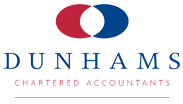Change to IHT on pensions proposals

Change to IHT on pensions proposals HMRC has published a policy statement announcing an important change to its plans to include pension savings in an individual’s estate for inheritance tax (IHT) purposes. What’s the full story? In her first budget last Autumn Rachael Reeves dropped a number of bombshells. Find the Help You Need with Our Accounting Services. One of the biggest was her proposal to bring pension savings and death benefits within the scope of IHT from 6 April 2027. Currently, IHT only applies in very few circumstances. Where it does the pension companies may be responsible for calculating and deducting any IHT payable before passing the pension savings to the deceased’s beneficiaries. The Chancellor wanted to emulate this process when the new IHT rules were rolled out in 2027. In a policy paper published on 21 July the government announced that the responsibility for calculating and paying IHT on pension saving will rest with the personal representatives of an estate, e.g. executors, and not pension companies. Although the consultation on the proposed new rules, which is open to everyone, doesn’t close until 15 September it had already become clear that the Chancellor’s original proposal was unrealistic. back to the menu top If you would like any assistance with any of these points. Please Call Us on 0161 872 8671 Get in Touch Want a financial consultation with no obligation? Call Dunhams Chartered Accountants now on 0161 872 8671 Or email paul.o’brien@dunhams.co.uk or andrew.edwards@dunhams.co.uk
Time off for fertility treatment?

Time off for fertility treatment? A survey by Fertility Matters at Work has revealed that more than one-third of employees undergoing fertility treatment have resigned or are considering resigning because of the physical and emotional toll. Is there a right to time off for fertility treatment? Employees have no specific statutory right to take time off work to undergo in vitro fertilisation (IVF) or other fertility treatment before the stage at which they are pregnant. However, as a minimum, you should treat time off for fertility appointments in the same way as any other medical appointments, e.g. if you allow up to two hours off work per medical appointment, you should allow at least the same time off for a fertility appointment, and if you pay staff for time off for medical appointments, you should do the same with fertility appointments. Find the Accounting Answers your looking for, with our Services. The intensive demands of IVF mean that more time off may be required, which you could allow the employee to take as a combination of paid leave, unpaid leave or holiday. You could also agree to a temporary informal flexible working arrangement, e.g. allowing them to make up the time, or to work from home if they live near their fertility clinic. You may also have contractual provisions in place governing paid or unpaid time off for fertility treatment, so make sure to check contracts and policies. If the IVF is successful and they remain pregnant, they have the same entitlements as any other pregnant employee, e.g. a right to paid time off for antenatal appointments, protection against pregnancy and maternity discrimination and a right to maternity leave. If the IVF embryo implantation fails, the employee’s pregnancy and maternity discrimination protection will end two weeks after the negative pregnancy test. If they are then absent on medical grounds following their pregnancy loss, this would be sick leave. However, the Employment Rights Bill is being amended to extend a new statutory right to at least one week of unpaid bereavement leave to cover employees who suffer a pregnancy loss after less than 24 weeks of pregnancy in any way other than by a live birth, and this will include IVF embryo implantation failure. back to the menu top If you would like any assistance with any of these points. Please Call Us on 0161 872 8671 Get in Touch Want a financial consultation with no obligation? Call Dunhams Chartered Accountants now on 0161 872 8671 Or email paul.o’brien@dunhams.co.uk or andrew.edwards@dunhams.co.uk
HMRC’s new compliance check service
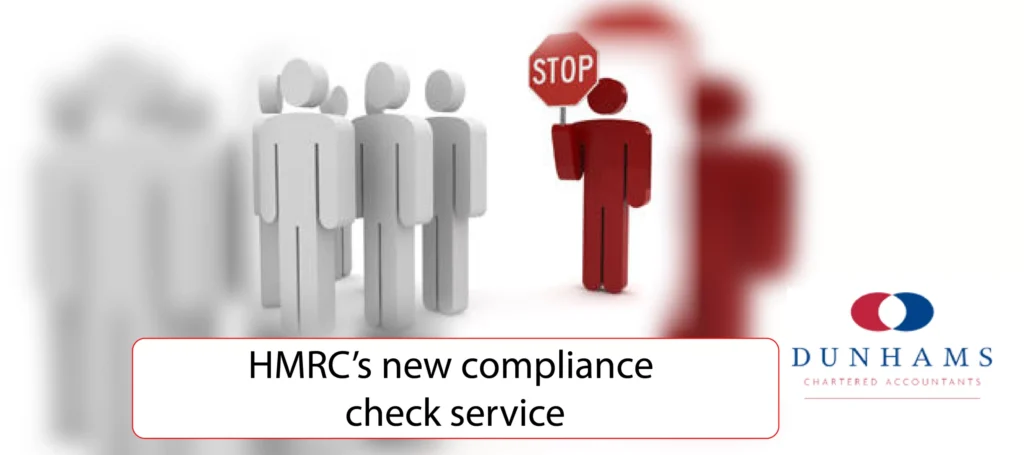
HMRC’s new compliance check service HMRC has published a collection of videos and notes to help if you’re picked for a compliance check. Is HMRC’s new service worth a look or is it just official propaganda? What’s a compliance check? Contrary to what you might have heard, a compliance check is not a tax enquiry. The latter is a review of a tax return that you’ve filed with HMRC, while a compliance check is a review of your current tax records. Sanctions, such as financial penalties for errors HMRC uncovers in a compliance check, are far less common than for a tax enquiry. A compliance check is aimed at making sure you’re on track to make a correct tax return. Get the Extra Assistance You Need, see our Accounting Services Don’t underestimate the likelihood of being picked for a check. HMRC carries out around 300,000 every year. The vast majority are made on businesses, especially those with employees or subscontractors. HMRC’s new service The compliance check service is primarily aimed at those without an accountant or tax advisor, but even if you do have one we think it provides useful information (click here for Further information). That said, the guidance is lightweight and comes across slightly condescending in places. Its best features are that it gives you an outline of what to expect, what happens at the conclusion of the check and what help HMRC can offer if you have issues which prevent you from engaging with the process properly, e.g. poor health or a disability. In practice, nearly all compliance checks for businesses start with a letter and questionnaire about the nature of your activity and how you do it, e.g. whether you have employees, use subcontractors and the records you keep. Take care in answering as it sets the tone for the check and largely determines what steps HMRC will take next, e.g. ask for documents, request to visit your premises or keep the check at a low level. If you’re unsure about answering, take advice from an accountant before responding. back to the menu top If you would like any assistance with any of these points. Please Call Us on 0161 872 8671 Get in Touch Want a financial consultation with no obligation? Call Dunhams Chartered Accountants now on 0161 872 8671 Or email paul.o’brien@dunhams.co.uk or andrew.edwards@dunhams.co.uk
Income sharing trouble for separated couple
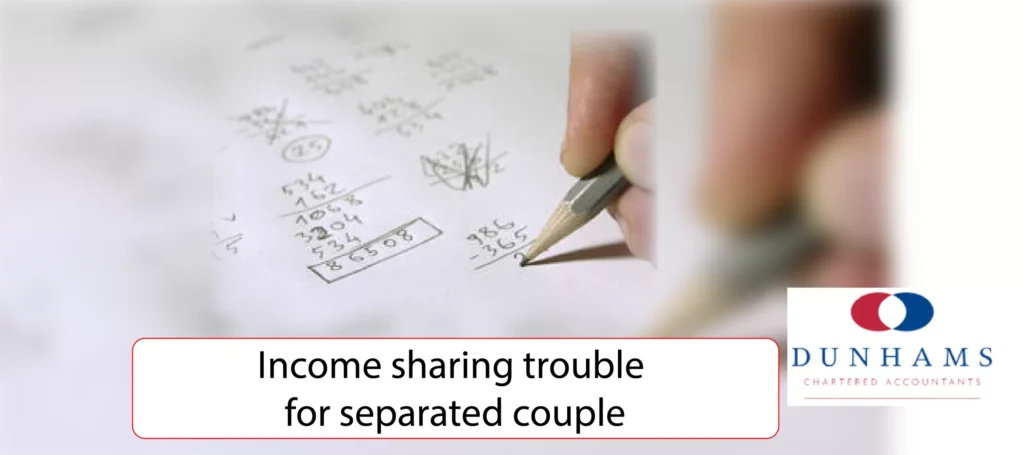
Income sharing trouble for separated couple After a couple separated one spouse received income from letting the property she jointly owned with her estranged spouse. HMRC taxed all the income on her. Was it right to do so or should her spouse have been taxed on half the income? The facts of the case At the end of May 2025 the First-tier Tribunal (FTT) published its decision in the case of Alison Moss v HMRC (2025) (A v HMRC). The case was brought by A following her appeal against HMRC’s decision on a number of issues regarding the taxation of rental income. The main dispute concerned who was liable to pay tax on the income. A argued her estranged husband ought to be taxed on half of it as the property was jointly owned. HMRC believed A alone was liable. Find the Help you need, See our Accounting Services. Parting of the ways In 2015 A’s husband went abroad to work giving her authority (by a power of attorney) to make financial decisions in respect of the property. For whatever reason the couple permanently separated in 2016 but remained married. Because A’s husband made no financial provision for her she used the authority she had been given to generate income by letting it. A sold the property in July 2020. Joint asset joint income A’s main argument relied on the special rules that apply to joint income received for married couples. These say that irrespective of which spouse or civil partner is entitled to the income from a jointly owned asset, it will be taxed as if they were each entitled to half. Declare different interests in property Also, although a couple can declare and notify HMRC that they want to be taxed on income other than on a 50/50 basis, the declaration only allows attribution for income for tax purposes to be in proportion to their ownership share of the asset. For example, if a husband owns 75% of a property and his spouse 25%, they can jointly choose to notify HMRC that they wish to be taxed on income in those proportions. In this case such a declaration was not possible as A and her husband owned the property in equal shares. FTT decision In respect of A’s argument that her husband should be taxed on half the income, the decision for the FTT was simple to arrive at. While the judges expressed sympathy for the financial position A had been put in by her husband, the fact was that at the time the letting income started the couple were permanently separated and therefore, in accordance with tax rules, were not to be treated as married (or in a civil partnership) from the date of separation. The 50/50 rule ended on that date. Instead, the income was attributable however the joint owners decided and was taxed accordingly. Because A made the decision to let the property (the power of attorney gave her the authority) and received the income without any direction from her estranged husband, she was the sole recipient of the income and therefore taxable on all of it. The point the FTT judges made regarding the allocation of income by joint owners who are neither married nor in a civil partnership is important. If you own property with someone but you’re not a married couple or civil partners, you can allocate the income between you in whatever proportion you like and you’ll be taxed accordingly. back to the menu top If you would like any assistance with any of these points. Please Call Us on 0161 872 8671 Get in Touch Want a financial consultation with no obligation? Call Dunhams Chartered Accountants now on 0161 872 8671 Or email paul.o’brien@dunhams.co.uk or andrew.edwards@dunhams.co.uk
MONTHLY FOCUS: INTRODUCING R35

MONTHLY FOCUS: INTRODUCING R35 The rules known as IR35 are complicated in practice. In this Monthy Focus, we introduce the rules and explain the contractual factors HMRC will look at when considering whether they apply to a particular engagement. Page Content:- IR35, what is it and how does it affect tax and NI? Employment status Contracts and arrangements 1. IR35, what is it and how does it affect tax and NI? What is IR35? IR35 is not an official set of tax rules. It was the reference given to information documents released as part of the 1999 Budget statement, marking the beginning of a long consultation. It suggested a solution to prevent the loss of tax and NI contributions where individuals, who would otherwise be subject to PAYE on their income, provided their services through companies they owned. The main sector where the government saw this as a problem was the IT industry. This perception still lingers. Naturally, IR35 met with a great deal of opposition (this remains true today) not least from the businesses that the would-be employees worked for, particularly banks, insurance companies and big businesses. If the government got its way, they were concerned that it might lead to the granting of employment rights to the persons now working for them through their own companies, not to mention employers’ NI contributions. In the end, the legislation which came out of the IR35 consultation in 2000 placed the burden of PAYE tax and NI on the workers (or to be more accurate their companies) and not their clients. Whether the IR35 rules apply to work an individual’s company contracts for turns on whether or not they would be classed as an employee if they worked for the client directly. Find the Help You Need, with Accounting Services. What are the “off-payroll” rules? The off-payroll rules were introduced in two stages. The first took effect in April 2017 and was limited to contracts for work with public bodies. The second stage, applying from April 2021, extended the 2017 rules to work done for private sector clients. However, these rules do not apply if the engaging client is a small company, business or other organisation. The meaning of “small” changed in April 2025, and is looked at in detail later. The main effect of the off-payroll rules is to put the onus on the business etc. receiving or paying for the services of individuals via an intermediary. Where the off-payroll rules don’t apply, the responsibility for deciding if IR35 applies remains with the individual doing the work or their intermediary, e.g. their company or partnership. In essence, the off-payroll rules are a mechanism for deciding who is responsible for determining a worker’s employment status, and, where it’s the recipient of the services (the client), how the process is administered, e.g. the calculation and deduction of PAYE tax and NI. What’s the effect of IR35 on tax and NI? As a business owner, especially a director shareholder, the effect of IR35 on income can be significant and it’s therefore not to be taken lightly. For example, if IR35 were applied to £40,000 of a company’s income, assuming the director had no other income, it would cost around £7,500 in PAYE tax, NI contributions, plus approximately £3,500 employers’ NI for the company (the company wouldn’t have a corporation tax bill). That’s a total of £11,000. This compares to a total cost of around £8,800 tax and zero NI if the same amount of income were taken as dividends. The extra costs must be accounted for out of the money the business charges the client. Working through a company or other intermediary whose income is caught by IR35 is doubly bad news. Not only will the individual suffer PAYE tax, employees’ and employers’ NI, but they won’t usually get the advantages usually associated with employees, namely employment rights such as statutory payments, e.g. sick pay and paid holidays. There are also some limitations on job-related expenses that can be claimed, specifically travel costs. Get in Touch Want a financial consultation with no obligation? Call Dunhams Chartered Accountants now on 0161 872 8671 Or email paul.o’brien@dunhams.co.uk or andrew.edwards@dunhams.co.uk 2. Employment status Who and what does IR35 apply to? IR35 applies to work done by individuals through intermediaries, e.g. companies and partnerships (but mainly the former). It applies where the services of an individual are made through an intermediary in which the worker has an interest, for example they own 5% or more of the shares in a company which has a contract to carry out work for a client. HMRC often refers to these as personal service companies (PSCs). IR35 doesn’t automatically apply to all the work done through the company etc. Each contract for work must be tested to see if IR35 applies. The question that must be asked is really one of employment status, Would the individual be employed by the client if the PSC (or other intermediary) wasn’t placed between them? Because each contract with each different client must be tested it means IR35 might apply to some of the company’s income but not all of it. Note. IR35 doesn’t apply if someone works directly for a client and not through a company or partnership. The same arguments are involved, i.e. whether the work is or isn’t on an employed basis, but the responsibility for determining this rests with the person the individual is working for. What are the three key conditions when considering employment status? Employment status is often not easy to establish. There are indicators which point to employment status, while equally there are those which point to self-employment. In a dispute with HMRC over status it generally puts emphasis on the former. Individuals should do the opposite if they want to avoid IR35 applying. The key employment status indicators used when considering IR35 originate from Ready-Mixed Concrete (South East) Ltd v Ministry of Pensions and National Insurance 1968. There are three conditions, all of which have to apply for an employment to exist. Where
Scammers already targeting pensioners over winter fuel payments
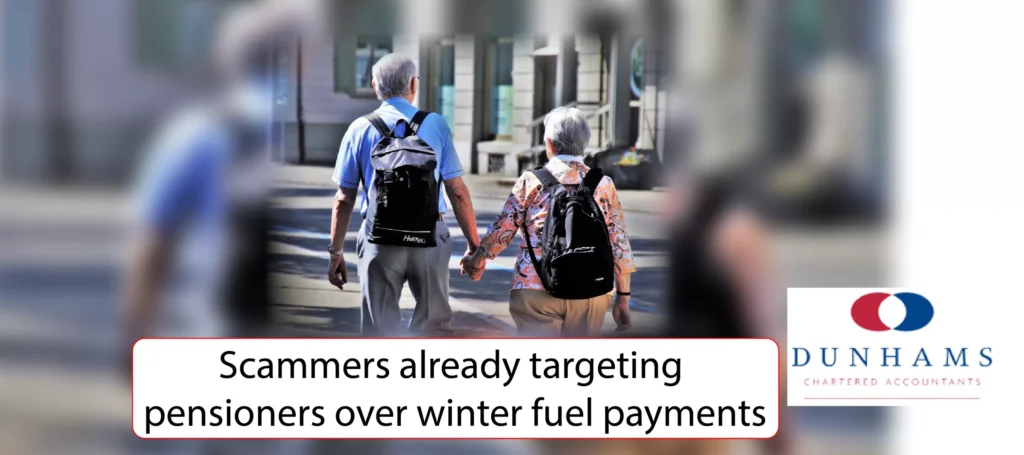
Scammers already targeting pensioners over winter fuel payments Phishing attacks are already being sent to pensioners purporting to be from the Department for Work and Pensions (DWP). What’s going on and how can you avoid becoming a victim? Last week we reported on the government’s announcement on winter fuel payments for 2025/26. According to a report by the ICAEW, it appears that scammers began targeting pensioners almost immediately. Find more help with our Personal tax services The winter fuel payment will be paid to state pension recipients and is worth £200 per household, or £300 if you’re over 80. In an attempt to defraud state pensioners, criminals are sending a text message that claims to be from the DWP. Get more assistance with Financial Planning. The recipient is asked to click on a link by a specified date to apply for an energy support grant. It comes with a warning that they will lose out if they do not apply in time. As the government has confirmed that the winter fuel payments will be made automatically, any attempt to get you to apply for it should be ignored. No application process exists, and no action needs to be taken. back to the menu top If you would like any assistance with any of these points. Please Call Us on 0161 872 8671 Get in Touch Want a financial consultation with no obligation? Call Dunhams Chartered Accountants now on 0161 872 8671 Or email paul.o’brien@dunhams.co.uk or andrew.edwards@dunhams.co.uk
Winter fuel payments to be clawed back via tax system
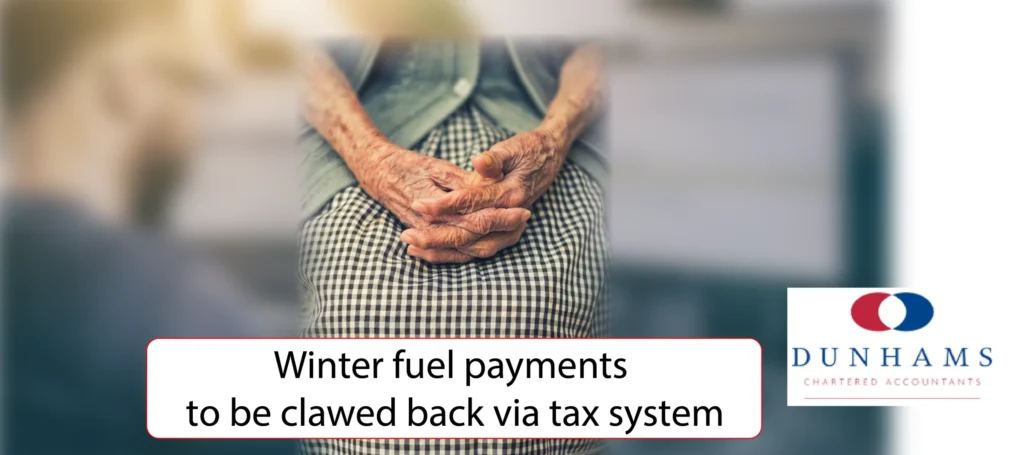
Winter fuel payments to be clawed back via tax system A government U-turn on the winter fuel payment was announced this week, with a new means-tested threshold. How will this work in practice? Get the Help you Need. see our Personal Tax Services. Recent weeks have been rife with speculation that the government would announce a climbdown for the current year, and this has now happened. Under the new system, all pensioners will initially receive the winter fuel payment. For those with incomes above the new threshold of £35,000, this will then be clawed back via PAYE or self-assessment (as applicable). The government has confirmed that this threshold will apply to each individual, not to each household. The threshold includes all sources of taxable income, so pensions (including the state pension) will be included, but qualifying ISA interest won’t be. It will be possible to opt out of receiving the payment, e.g. where you know your income will exceed the threshold. Crucially, the government has confirmed that nobody will need to register with HMRC as a result of the changes. back to the menu top If you would like any assistance with any of these points. Please Call Us on 0161 872 8671 Get in Touch Want a financial consultation with no obligation? Call Dunhams Chartered Accountants now on 0161 872 8671 Or email paul.o’brien@dunhams.co.uk or andrew.edwards@dunhams.co.uk
The benefits of AI training
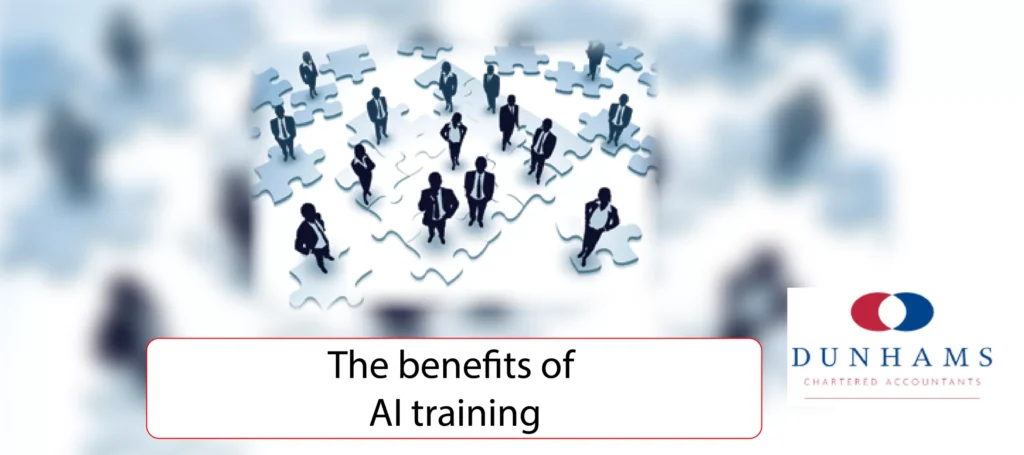
The benefits of AI training Corndel’s 2025 Workplace Training Report has revealed that only 39% of employees have received AI training from their employers. What are the benefits of training your staff in the use of AI in the workplace? For more Help Managing your Business see our Accounting Services. It’s likely that many of your employees are already using generative AI tools to help them with their work-related tasks. You may well have set out your approach to the use of AI in the workplace in a generative AI policy, and if you haven’t done this already, you should do so. However, you should also go one step further and provide staff with AI training. Investing in AI training can enable you to: reiterate the provisions of your policy equip employees with the skills to understand and use AI tools effectively to improve their roles – as AI tools can automate repetitive tasks and streamline workflows, training staff to use them effectively, and on how to get the best outputs, can significantly increase their productivity guide employees on how to handle data input in a safe and secure manner and educate them about the risks associated with AI-generated content, such as bias or inaccurate outputs, ensuring that they use AI tools responsibly demonstrate that you are committed to upskilling employees and fostering AI literacy across your business. The Corndel survey also revealed that only 14% of employees considered their AI training to be highly effective, so you might want to look at what you can do to ensure your training hits the mark. For example, consider providing tailored, practical, small group training in the specific AI tools used in your business. Do also involve your IT team in this. You should make the training accessible to everyone, and you may decide to make it mandatory as all employees can benefit from understanding how AI impacts their role. Finally, refresh your training regularly as AI is constantly developing. back to the menu top If you would like any assistance with any of these points. Please Call Us on 0161 872 8671 Get in Touch Want a financial consultation with no obligation? Call Dunhams Chartered Accountants now on 0161 872 8671 Or email paul.o’brien@dunhams.co.uk or andrew.edwards@dunhams.co.uk
Is it a fix? HMRC’s updated employment status tool
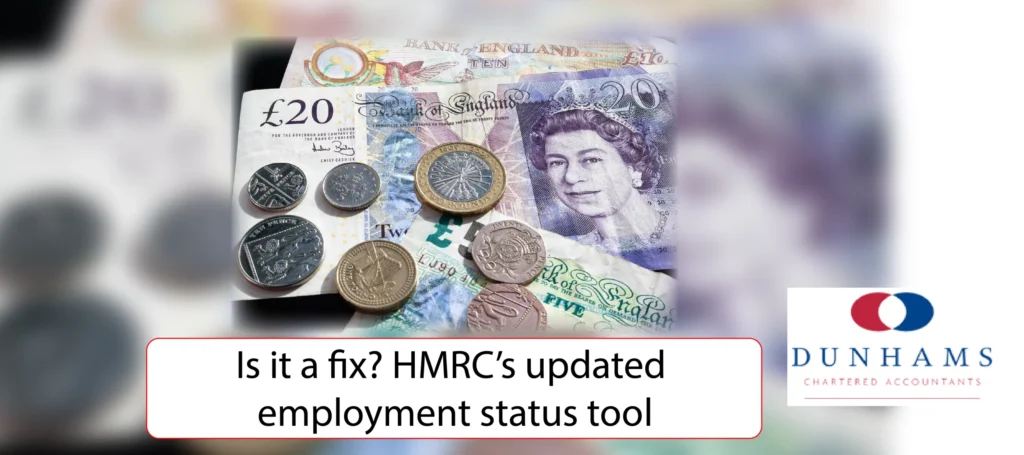
Is it a fix? HMRC’s updated employment status tool HMRC has revamped its “check employment status for tax” tool (CEST) and amended its guidance. What’s new and is it any better than the previous version at deciding on a worker’s employment status? Why is status important? For many years HMRC has targeted workers who provide their services in person via intermediaries, such as personal service companies (PSCs). HMRC’s perception is that many are disguising an employment income to escape PAYE tax and NI. The rules (known as IR35 ) affect either the PSC or, through the off-payroll rules, the PSC’s customer as a deemed employer. Example. Bob is a director shareholder of Bcom Ltd. BigCo plc engages Bcom Ltd on a full-time contract to runs its IT back office. HMRC will want to know whether, without Bcom, Bob would have been an employee of BigCom, no matter what any contract between them says. Get the help your Business Needs with Our Accounting Services. How to decide Where an intermediary supplies the services of a worker a determination needs to be made whether after taking the intermediary out of the equation they would be an employee of the company. There can be a high cost in terms of time and money if HMRC doesn’t agree with you. The check employment status for tax (CEST) tool is supposed to help by providing clarity. The tool itself The tool asks a series of questions about the contractual relationship between the worker and the client. The preamble now refers to the CEST “determination”, wrongly inferring that the CEST result is final – it really isn’t. In fact, despite the update the logic behind the tool hasn’t changed at all, which means a user before the upgrade will still receive the same outcome if they rerun it again. Given that 20% of the time the CEST tool still “cannot determine” the position it’s hardly much of an improvement. Notwithstanding that, HMRC says it will be bound by the result given by the CEST tool if you’ve answered its questions accurately. If you have the result you wanted from the pre-updated CEST tool, there’s no need to check it again but it might be worthwhile if the converse is true. What’s new? Crucially, the CEST tool now asks if a contract for work is or will be in place, and if you answer “no”, it won’t continue. This change concerns the obligation of an employer to provide work in return for a wage, known as the mutuality of obligation, which has been at the centre of recent court rulings. Other than that the changes to the CEST tool are largely cosmetic. New guidance What’s more interesting is the updated guidance. It has been significantly changed and more examples added relating to: when the right to substitute the person doing the work or engaging a helper who’s not essential to the work, has no affect on employment status; and the impact of financial risk on the person doing the work (or the intermediary, e.g. their PSC). Examples are costs incurred by the intermediary or worker that cannot be recovered from the customer and, responsibility to rectify substandard work. back to the menu top If you would like any assistance with any of these points. Please Call Us on 0161 872 8671 Get in Touch Want a financial consultation with no obligation? Call Dunhams Chartered Accountants now on 0161 872 8671 Or email paul.o’brien@dunhams.co.uk or andrew.edwards@dunhams.co.uk
New PAYE procedure being overlooked
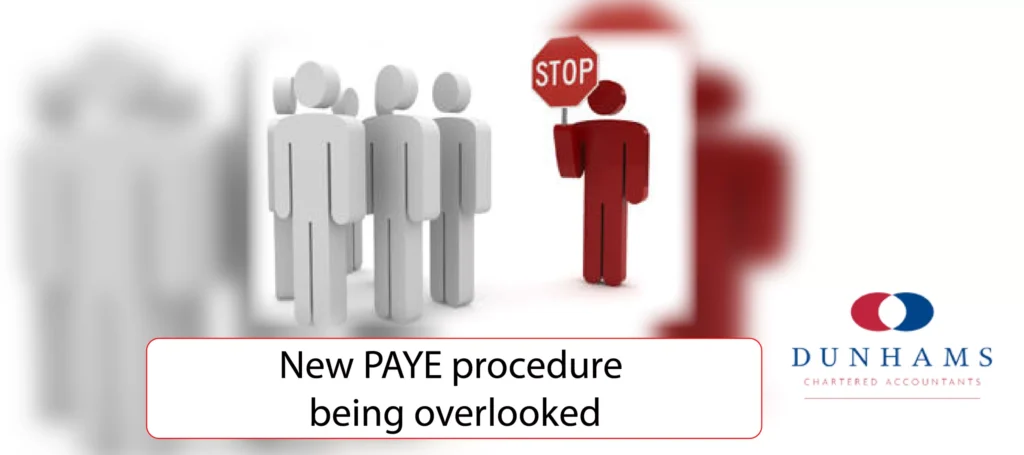
New PAYE procedure being overlooked If you pay foreign employees or those who work abroad, you might need to take steps immediately because of new tax rules. What’s the full story? Accountancy and tax organisations are warning employers that they are at risk of falling foul of HMRC if they don’t follow the new tax residency rules that took effect in April 2025. The changed rules are a side effect to the overhaul of the UK taxation of non-UK individuals, known as the “foreign income and gains” (FIG) regime. The rules also affect UK individuals paid by UK employees for work they do abroad. Get more from Our Accounting Services. Tax only UK earnings. If one of your employees works both in and outside of the UK, before April 2025 you could have asked HMRC for permission to only apply PAYE to salary relating to their UK work. This was called “s.690 relief” . This relief came to an end with the introduction of FIG. New process. Since April 2025 employers should not assume that employees who qualified for s.690 relief will do so under the FIG regime. Because of this there’s a new mandatory process for employers to follow if they want to limit PAYE to operate the new version of s.690 relief. Find the Financial Planning you Need. The good news is that the new process is all online and can be completed by you or your accountant in very little time and it has immediate effect. This means that you don’t need to wait for HMRC’s permission before limiting PAYE to UK-generated earnings. The new process must be followed for employees for whom you have previously received permission from HMRC under the old rules. The new procedure only relates to PAYE tax. It doesn’t affect your or your employees’ NI contributions if they are foreign nationals. There are separate rules for these back to the menu top If you would like any assistance with any of these points. Please Call Us on 0161 872 8671 Get in Touch Want a financial consultation with no obligation? Call Dunhams Chartered Accountants now on 0161 872 8671 Or email paul.o’brien@dunhams.co.uk or andrew.edwards@dunhams.co.uk
